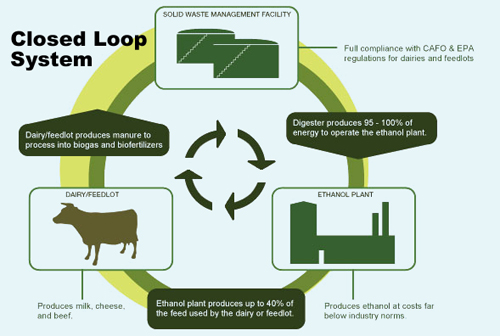U.S. Environmental Protection Agency Proposes Strategy to Reduce Foreign Oil Dependency
|
"For years, our nation's rolling farm fields have filled America's breadbaskets. Now these same fields are filling America's gas tanks," U.S. EPA Administrator Stephen L. Johnson said at the announcement.
Why Mead?
The federal environmental agency selected a model ethanol plant, E3 Biofuels, near Mead, Nebraska, for this national announcement because the plant combines a large feedlot with an ethanol plant that uses manure from the feedlot to power the ethanol plant. One of the by-products from the production of ethanol, wet distillers grains, can be fed to the cattle, eliminating drying and transportation of the feed by-product. This closed-loop system will significantly reduce the fossil fuel used in the production of ethanol.
A national Renewable Fuels Standard will expand the use of biodiesel and ethanol, creating new markets for farm products and greater energy security. Advanced technologies under development could make it possible to produce renewable ethanol from agricultural and industrial waste at a cost competitive with today's gas prices.
 EPA Administrator Johnson, Governor Heineman, and E3 Biofuels plant owner David Hallburg discuss aspects of the Nebraska closed-loop ethanol plant. |
Cutting Foreign Oil Use
The new regulation proposes that 3.71 percent of all the gasoline sold in 2007 be renewable fuel. In December 2005, EPA issued a standard of 2.78 percent for 2006, which will continue to apply through this calendar year. The Renewable Fuels Standard program is designed to cut petroleum use by approximately 3.9 billion gallons a year in 2012 and reduce greenhouse gas emissions by up to 14 million tons annually.
Various renewable fuels can be used to meet the requirements of the program, including ethanol and biodiesel. While the Renewable Fuels Standard program provides the certainty that a minimum amount of renewable fuel will be used in the United States, more can be used if fuel producers and blenders choose to do so. In 2006, there will be about 4.5 billion gallons of renewable fuel used as motor vehicle fuel in the United States. The program requires that this volume increase to at least 7.5 billion gallons by 2012.
 Nebraska Selected for Grant to Study Ethanol Industry
Nebraska Selected for Grant to Study Ethanol Industry
Gov. Dave Heineman said the state received a $70,000 grant from the Western Governors' Association to measure the energy components and environmental impacts of Nebraska's ethanol industry. The Governor made the announcement at a groundbreaking for the E3 Biofuels Complex near Mead in September 2006. The cattle and ethanol complex, scheduled for completion this fall, will provide much of the study's data.
"This grant will create a yardstick by which the ethanol industry can measure its progress," Gov. Heineman said. "All phases of ethanol production will be studied with the goal of making ethanol production operations more efficient and finding ways to cut costs. With this effort, Nebraska will continue its leadership in national ethanol production."
The 18-month project will develop an easy-to-use computer model to estimate energy yield, energy efficiency and environmental impacts of bio-refinery corn-to-ethanol, stover and sorghum production systems based on component technologies and environmental conditions. The resulting software will be made available to industry, government and researchers to help biomass production facilities find ways to reduce energy waste, cut costs and improve the production of alternative fuels such as ethanol and biodiesel.
The grant program was initiated by the WGA and the U.S. Department of Energy through the National Biomass State and Regional Partnership. The Nebraska project will involve the Nebraska Energy Office, the Nebraska Department of Agriculture and the University of Nebraska-Lincoln's Department of Agronomy and Horticulture.
